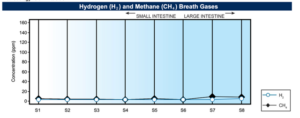What do my SIBO breath test results mean?
 If you have had a SIBO breath test and seen your results, I bet you are probably wondering what do the results mean for you.
If you have had a SIBO breath test and seen your results, I bet you are probably wondering what do the results mean for you.
General Interpretation Principles for SIBO Breath Test
Interpreting a SIBO breath test involves several key guidelines. First, humans do not produce hydrogen or methane, so their presence indicates microorganisms in the gastrointestinal (GI) tract. Although humans produce hydrogen sulfide, excess amounts on a test suggest microorganisms are overproducing it.
Second, understanding transient time is crucial. This refers to the 90 minutes it takes for a lactulose solution to pass through the small intestine. A hydrogen gas increase of 20 ppm or more within this time frame suggests SIBO caused by hydrogen-producing microorganisms.
Methane interpretation differs: a methane level of 10 ppm or greater at any point indicates intestinal methanogen overgrowth (IMO). Some clinicians consider 3 ppm or greater as positive for patients with constipation.
Diagnosing hydrogen sulfide SIBO is more nuanced. Only one test directly measures hydrogen sulfide, while others measure only hydrogen and methane. Diagnosis depends on patient symptoms and the pattern of these gas levels.
Straightforward Test Example of SIBO Breath Test
In this patient, there is clearly a rise of greater than 20 ppm of hydrogen gas. There is also clearly greater than 10 ppm of methane gas during the test. So this patient has both hydrogen SIBO and IMO. This patient is being treated for both hydrogen and methane SIBO.
Nuanced Test Example of SIBO Breath Test

This patient has a lot of gas, bloating and significant constipation. So while this patient did not have greater than 10 ppm of methane gas during the test, she had 9 ppm of methane gas in the presence of significant constipation. Thus she was diagnosed and treated for IMO with subsequent improvement.
Bottomline
Testing for diagnostic purposes and retesting after therapy is crucial. The initial testing identifies the gas or gasses present, thus allowing for the appropriate therapeutic option to be started. Retesting is very beneficial, especially if symptoms persist or if the initial gas levels were very high. Retesting allows for the assessment of therapeutic effectiveness and gives information to guide additional therapy. For a detailed guide on the functional medicine SIBO protocol, check out our lab partner Rupa Health’s article here.
Remember you are important. Your health is vital to all you want to do and become. We at Vytal Health are here to help. Learn about Dr. Carr
